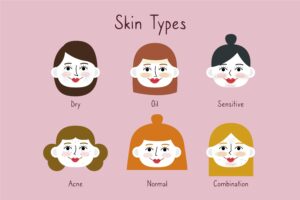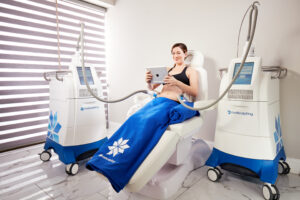Shockingly enough, lasers have been used in dermatology since 1963 when introduced by Dr. Leon Goldman. Since then, they’ve come a long way from the ruby rod emitting laser, and these are some of the most well-known and commonly used lasers in dermatology today.
Overview
A laser, an acronym for light amplification by stimulated emission of radiation, emits light energy that targets a specific area. Nowadays, there are both cold and hot lasers. Cold lasers use low levels of light that does not heat the skin. Conversely, hot lasers use high-intensity light energy that heats the skin.
No matter the energy’s intensity, lasers work in the same manner; they do controlled damage to the targeted area. The body then sends additional collagen to the region for repair. Essentially, this either speeds up the healing time or corrects the problem.
Moreover, practitioners use various types of lasers in dermatology, such as the following:
- CO2 lasers
- Erbium lasers
- Pulsed-dye lasers
- Fractional lasers
- Intense pulsed light (IPL)
It’s also important to note that laser therapy for acne and other skin conditions is a solution if you’re looking for non-invasive cosmetic procedures in NY.
CO2 Lasers

CO2 lasers use carbon dioxide to successfully remove thin layers of skin without damaging the surrounding or underlying tissue. Because your body will send collagen to repair the area, a new layer of skin is exposed but the therapy won’t thin the skin.
Translucent Skin Treatment
Specifically, a specialist may recommend C02 laser therapy if you have translucent skin. With this issue, you can easily see the blood vessels and soft tissue. Translucent-skinned people are more likely to have bruising and skin tears. Laser therapy may help thicken the skin and prevent these issues.
Skin Lesion Treatment
A CO2 laser may effectively treat benign skin lesions, like moles. Before this treatment, though, the practitioner will thoroughly evaluate the mole to ensure it’s non-cancerous. For instance, the doctor will check to see the color, size, and borders of the mole. A practitioner will look to see if it’s oozing or scaly.
Treating Warts
This type of laser is one of the non-invasive cosmetic procedures in NY for warts. All warts come from the human papillomavirus (HPV). While this condition is known to cause cancer, it most often causes common warts, and these unsightly skin blemishes aren’t cancerous. They won’t be bothersome either. However, a person may want to have them removed for aesthetic reasons, and this is possible through a CO2 laser.
Erbium Lasers

Erbium lasers are similar in nature to ones that use carbon dioxide. It uses rare earth metal erbium to target the affected region. Like C02 lasers, erbium lasers heat the skin and cause microscopic injuries to it. They aren’t painful but stimulate your body to send additional collagen to help with healing.
Moreover, this type of laser affects little of the skin surrounding the treatment area. A dermatologist may use an erbium laser to remove warts, lessen the severity of wrinkles and fine lines, and reduce the appearance of sun damage.
Hyperpigmentation
A practitioner might recommend an erbium laser treatment for hyperpigmentation — a skin condition that occurs when you have areas of skin that are darker than others. It stems from the skin cells producing more melanin in that area. One specific type of hyperpigmentation that a practitioner may treat with an erbium laser is age spots. They arise from sun damage. Your practitioner may refer to them as solar lentigines. Most commonly, they’re found on your face and hands but can occur anywhere that has a great deal of sun exposure.
Freckles
Some people find freckles cute and appealing. But, not everyone who has them feels this way. It doesn’t help that freckles can arise and become more prevalent due to the sun. With an erbium laser treatment, a practitioner may lessen the appearance of these skin blemishes and possibly even remove them.
Scars and Birthmarks
Scars and birthmarks aren’t serious but can very well interfere with your self-confidence. Fortunately, with CO2 laser therapy, a practitioner can effectively target these issues. In fact, this treatment is even beneficial if you have acne scarring, which is a common problem. Specifically, an estimated 80 percent of people between the ages of 11 and 30 have acne. About 20 percent of those individuals develop scarring. With the use of an erbium laser, a specialist can reduce or completely eradicate the scarring without damaging any of the nearby, unscarred skin.
Fine Lines and Wrinkles
This type of laser is also beneficial in reducing the appearance of fine lines and wrinkles and healing sun-damaged skin.
Pulsed-Dye Lasers

Pulsed-dye lasers are different from both erbium and CO2 lasers. Although they use light energy converted into heat like the aforementioned lasers, they use an organic dye for the laser effect. Rather than targeting scarring and melanin, pulse-dye lasers use gentle bursts of light directed at the blood vessels. The light energy then damages the blood vessels while keeping the skin and other vessels in the area safe. Once the blood vessel closes, it’s then absorbed by your body. Your healthy blood vessels in the region then pick up the slack and transport the blood.
Some examples of conditions treated with pulsed-dye lasers include:
- Hypertrophic scars
- Rosacea
- Port-wine stains
- Telangiectasis
- Keloids
Hypertrophic Scar
A hypertrophic scar is a raised scar that arises from an abnormality in the wound healing process. Most often, they happen from surgical incisions, burns, or other skin trauma.
Rosacea
In addition, a practitioner might advise you to undergo pulsed-dye laser therapy if you have rosacea. Individuals who have this condition experience flushing or blushing on their faces. The blood vessels may become visible in the area. Sometimes, small, pus-filled lumps will occur. When a specialist uses a pulsed-dye laser, it targets the blood vessels on your face contributing to the rosacea.
Port-Wine Stain
A port-wine stain is a birthmark that’s a deep red color and looks like red wine was spilled on your skin. While you see the birthmark itself, underneath the surface of the blemish are swollen blood vessels. The laser will target and shrink them, reducing the appearance of the birthmark.
Telangiectasis
Telangiectasis describes an issue that occurs when you have dilated capillaries. They appear red or purple and appear in clusters. In many cases, they look spider-like. The practitioner will aim the laser at the capillaries, which in return, corrects the unpleasant look of this condition, once your body absorbs them.
Keloid
A keloid is another example of a skin condition treated with this variety of laser. They’re a type of scarring most commonly found on the skin of people with darker skin. A keloid could appear from any issue that caused a scar, such as a tattoo, cut, severe acne, or burn. A keloid may grow even larger than the original scar and can expand for years. The pulsed laser decreases vascularization, which results in reducing the appearance of the keloid.
Intense Pulsed Light (IPL)

An intense pulsed light (IPL), also referred to as a photofacial, is a treatment that uses laser energy to correct issues with the texture and color of your skin. Particularly, a practitioner may suggest this laser treatment for sun spots, unwanted hair, varicose veins, rosacea, or wrinkles, to name a few examples.
Whilst IPL is similar to laser treatments, it differs slightly. Laser treatments direct one wavelength of light toward your skin. On the contrary, IPL emits different wavelengths. A laser is a more focused light treatment than IPL. For this reason, a practitioner can use it to target problems deeper in the skin, particularly in the dermis. The treatment won’t harm the epidermis — your top layer of skin, though.
Like other laser therapy, the skin absorbs light energy and turns it into heat. It damages the pigment cells, which decreases or eliminates issues caused by hyperpigmentation, including freckles.
Unwanted Hair
You may use this treatment to remove unwanted hair. It works by sending light energy to where the melanin is. The hair and bulb absorb the heat from the light. During this process, the energy destroys the papilla, which is the part that produces hair.
Sun Spots
Sunspots, also known as liver or age spots, stem from the sun and become more common once a person is 50 or older. They come from overactive pigment cells caused by the ultraviolet rays of the sun increasing melanin production in the area. Within seven to 14 days of your IPL treatment, you may notice a difference in the darkness of your sunspots.
Varicose Veins
You may receive IPL for small varicose veins. Although this treatment may decrease the appearance of larger ones, those will require other means of treatment to fully correct. When it comes to the smaller veins, though, this is one of the non-invasive cosmetic procedures in NY that target the blood vessel. It applies heat to the venous walls and damages them. The body then absorbs the vein and removes this unsightly problem.
These are some of the most common lasers used in dermatology. They all have different uses but work in slightly similar ways. Fortunately, when you visit a trained specialist, you and the practitioner can discuss your problems and determine which, if any, laser treatment is right for you or if one of the other non-invasive cosmetic procedures in NY is a better solution.
Book an appointment with Bared Monkey to discuss one of our laser treatments, such as laser hair removal, by calling 212-256-9777.



